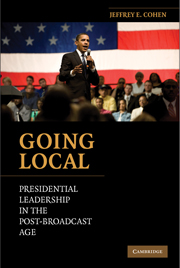Book contents
- Frontmatter
- Contents
- List of Figures
- List of Tables
- Introduction
- 1 Context and Presidential Leadership Styles
- 2 Increasing Presidential Attention to Narrow Groups
- 3 Presidents and the Local News Media
- 4 A Theory of Presidential News Management and Local News Coverage
- 5 The Quantity of Local Newspaper Coverage of the President
- 6 Trends in Local Newspaper Coverage of the Presidency, 1990–2007
- 7 On the Tone of Local Presidential News
- 8 Local Presidential News Coverage and Public Attitudes toward the President
- 9 Conclusions: Presidential Leadership in the Post-Broadcast Age
- Bibliography
- Index
8 - Local Presidential News Coverage and Public Attitudes toward the President
Published online by Cambridge University Press: 05 June 2012
- Frontmatter
- Contents
- List of Figures
- List of Tables
- Introduction
- 1 Context and Presidential Leadership Styles
- 2 Increasing Presidential Attention to Narrow Groups
- 3 Presidents and the Local News Media
- 4 A Theory of Presidential News Management and Local News Coverage
- 5 The Quantity of Local Newspaper Coverage of the President
- 6 Trends in Local Newspaper Coverage of the Presidency, 1990–2007
- 7 On the Tone of Local Presidential News
- 8 Local Presidential News Coverage and Public Attitudes toward the President
- 9 Conclusions: Presidential Leadership in the Post-Broadcast Age
- Bibliography
- Index
Summary
Because of the rise of party polarization and an increasingly fragmented news media, key characteristics of the post-broadcast age, presidents no longer find a national leadership strategy to be as effective as it once was. In place of going national, presidents now place heavy emphasis on targeting segments of the mass public, in particular their party base, interest groups, and localities, for their leadership efforts. As argued in this book, localities are especially important targets for the president because of the potential influence of local public opinion on members of Congress. If presidents can mobilize local public opinion, then perhaps members of Congress, fearing or wanting to be responsive to their constituents, will also support the president.
Presidents have several ways of reaching local public opinion, including visiting localities and influencing their coverage in local newspapers. Visiting localities may enhance support within the visited locality, but mobilizing support in many localities requires numerous and frequent presidential visits, a costly method. Influencing local news coverage may be less costly and more efficient to presidents, but it is not without pitfalls.
To reach local publics, presidents rely heavily on the local news media, especially local newspapers. Local newspapers still possess relatively large readerships, still command respect from their readership, and they report measurable amounts of news about the president. The analysis of the past several chapters demonstrates that presidents, through their public activities, can influence the quantity and tone of their news coverage in local newspapers, establishing support for the first link in the causal chain.
- Type
- Chapter
- Information
- Going LocalPresidential Leadership in the Post-Broadcast Age, pp. 180 - 209Publisher: Cambridge University PressPrint publication year: 2009



